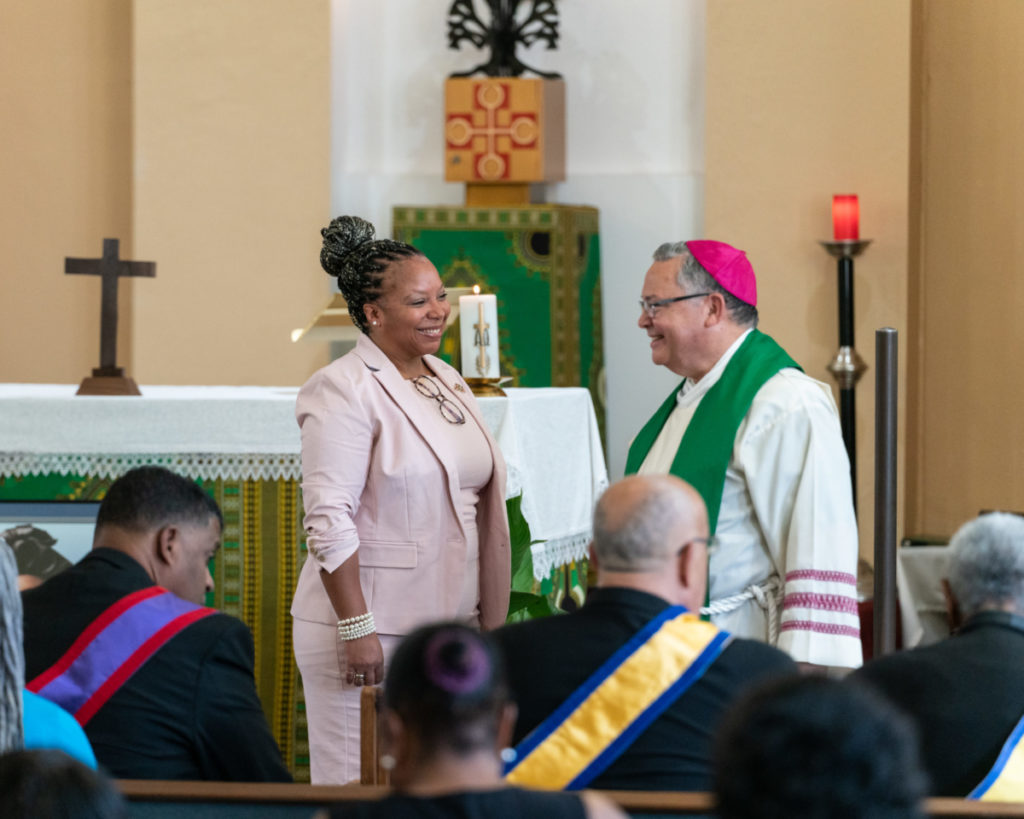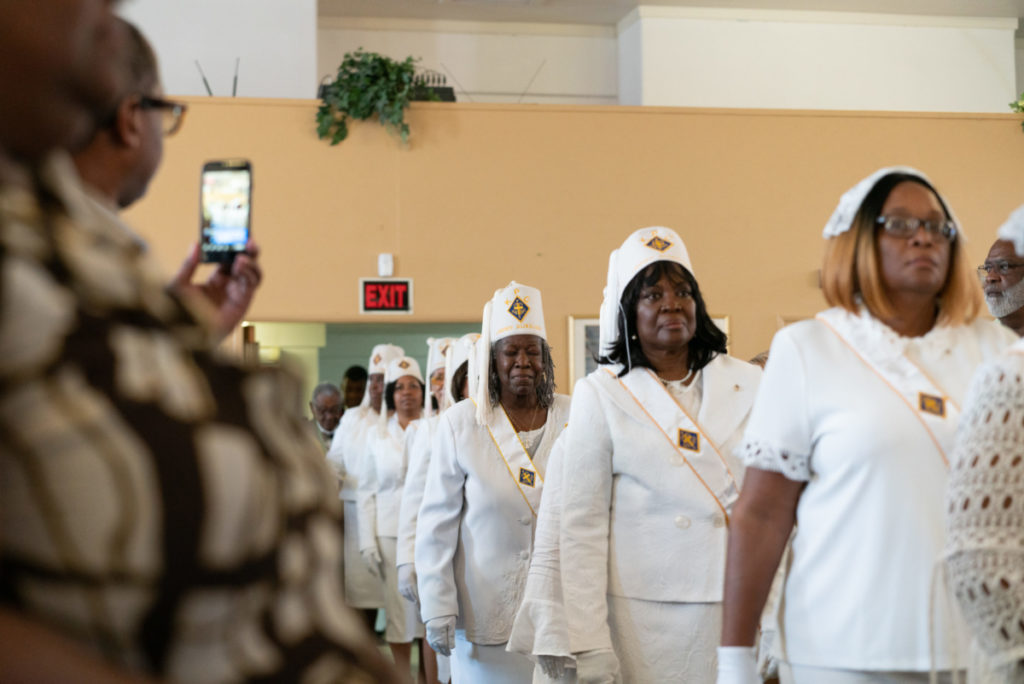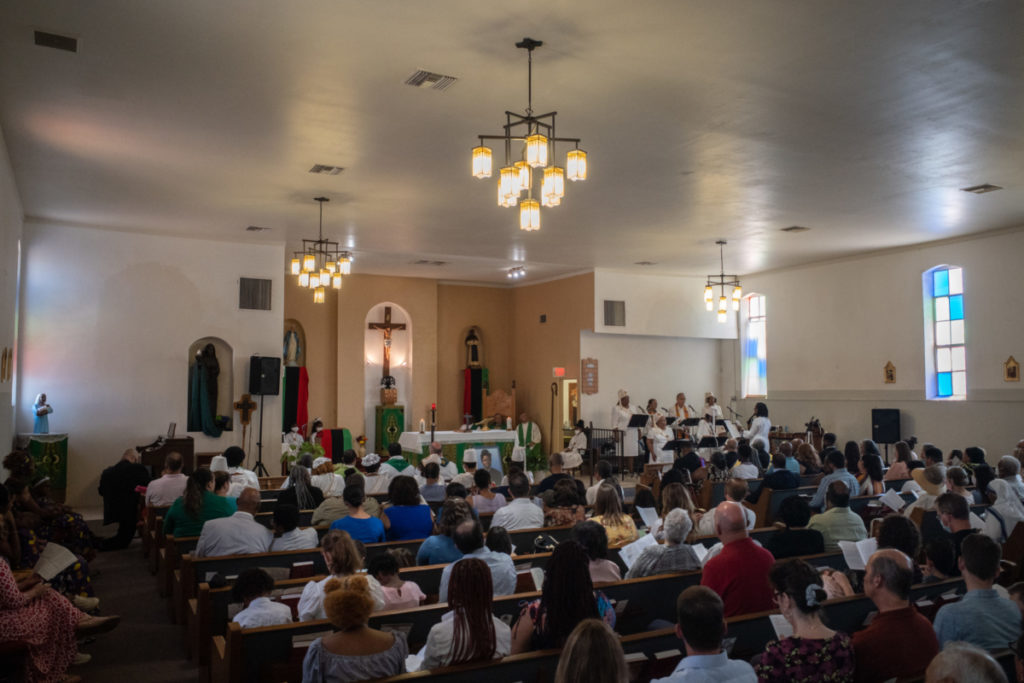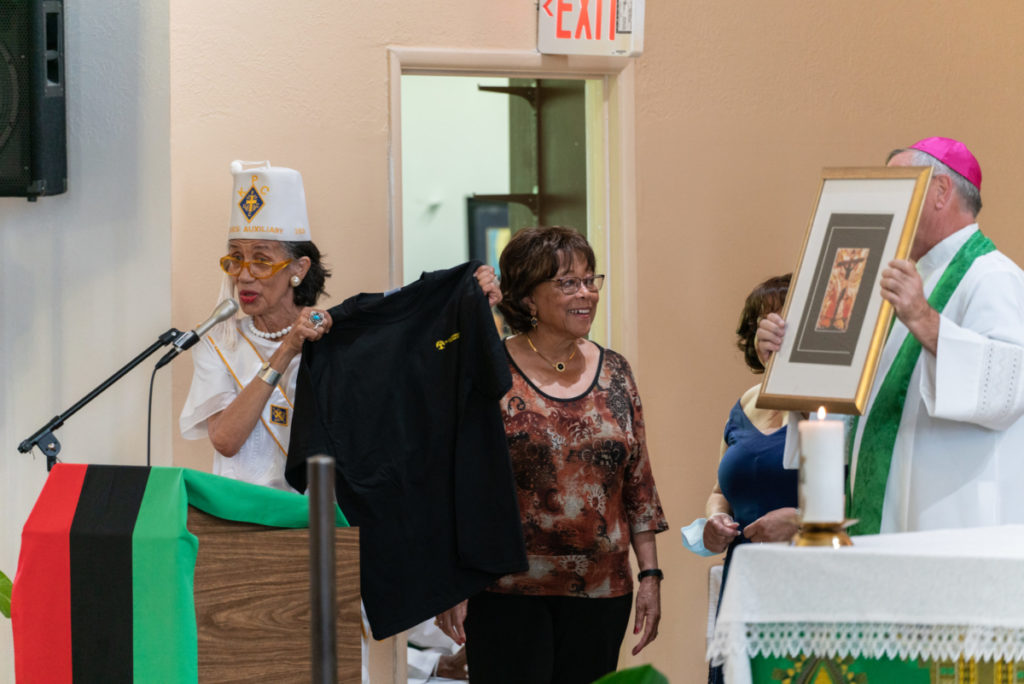By Tony Gutiérrez, The Catholic Sun
Decorated with banners bearing the Pan-African colors of red, green, and black and an image of St. Josephine Bakhita in the sanctuary in front of the altar, the St. Pius X Church building continued receiving visitors beyond capacity during a special liturgy Aug. 7.
After members of the Knights of Peter Claver set up extra seats along the walls of the church, the Mass began with the sound of a drum hearkening an African tradition of calling people to prayer. Close to 300 people filled the church to participate in the inaugural Mass for St. Josephine Bakhita Parish Mission.
“This is the day the Lord has made, let us rejoice and be glad!” declared Auxiliary Bishop Eduardo A. Nevares, the Mass’s main celebrant, during his homily, acknowledging the faithful efforts of the Diocese of Phoenix’s Black Catholic community leading to that day.
Faithful Witness
He tied in their faithfulness with that of Abraham and Sarah, the subjects of that day’s second reading taken from St. Paul’s Letter to the Hebrews.
“They were asked by God to leave their home, to leave their property, to leave their country, and to be able to be led into the Promised Land,” he said. “They took all of their sheep and cattle, they took all of their possessions, and they followed the Lord, all because of their faith.”
In a similar way, the mission’s new patroness — St. Josephine Bakhita — also remained steadfast in her faith. Born in the eastern part of Sudan in 1869, St. Bakhita was kidnapped at 9 years old and sold into slavery.
“She grew in a relationship with what she perceived to be her God,” the bishop said. “She looked at the sun, she looked at the moon, she looked at the thunder, the lightning, she looked at all of the nature, and these brought her to mind that there had to be a supreme being, there had to be someone, something that organized the entire universe.
Eventually, she was purchased by an Italian ambassador who sent her for instruction with the Canossian Daughters of Charity, Servants of the Poor. With help from the sisters, she was initiated into the Catholic Church and was able to legally obtain her freedom. In 1896, she professed her religious vows.
“At this time of her life, Bakhita said that she could hear more and more clearly the Lord’s gentle voice urging her to consecrate her life to God,” said Bishop Nevares. “St. Josephine Bakhita professed her religious vows and mentioned, ‘I was a slave for men. Now I will be a slave for Jesus Christ.’”
As Sr. Josephine, she lived in community until her death in 1947. Her cause of canonization began in 1958 under St. John XXIII. St. John Paul II declared her “Venerable” in 1978, beatified her in 1992, and canonized her in the year 2000.
“She had her struggles, she had her worry, she had her pains and suffering, and yet, she never allowed those to embitter her,” Bishop Nevares concluded. “In coming to know Jesus, the more she came to understand why God had allowed her to suffer — because now she could understand the suffering of her beloved spouse, Jesus Christ.”
In determining a name for the new parish mission, parochial administrator Father Andrew McNair was asked to submit three options to Bishop Thomas J. Olmsted — who was still serving the diocese as apostolic administrator over the summer. Those names included St. Augustine and St. Monica, together, St. Monica by herself, and St. Josephine Bakhita.
“She was a slave, a convert, and a model of forgiveness. The bishop liked it right away and said, ‘That’s it,’” recalled Father McNair. “The more I learned about her, it’s a perfect fit. Her holiness and sense of forgiveness and love — which is so needed today.”
St. Josephine Bakhita’s role as patroness is also fitting considering that the Diocese of Phoenix Prison Ministry continues to use the church campus for some of its activities.
“That’s definitely within the spirituality of Josephine Bakhita,” Father McNair said. “It’s about lost people and compassion and mercy for those who have suffered.”
Providentially, St. Josephine Bakhita is also the patroness for the local Knights of Peter Claver Ladies’ Auxiliary court — St. Josephine Bakhita Court 369. The Knights and Ladies of Peter Claver are the only fraternal benefits society established specifically for the African American Catholic community.
“She is one of our patron saints, and we chose that name because she was one of the few Black culture women in the Catholic Church that we can turn to,” said Mary Skinner, grand lady for Court 369. “We have a home parish that we can attach our organization to more clearly and that we can give more. We love the fact that we can give back to the community, and now they know where to find us. Now, they know that we are a parish on a mission.”
Establishing a parish
After Father McNair was appointed as chaplain of the African American Catholic Community in the diocese in April 2021, having a permanent spiritual home for the community became a long-term goal. St. Pius X was canonically established as Sacred Heart of Jesus when it was still under the Diocese of Tucson. It eventually became St. Monica — a popular saint among Black Catholics. When the pastor of that church, the former Franciscan Father Emmett McLoughlin, left the Catholic Church, the building was renamed St. Pius to distance itself from the scandal caused by Father Emmett’s departure.
It was suggested, Father McNair said, to erect a parish mission — canonically a “quasi- parish” — to fill that spiritual need. According to Canon 516 of the Code of Canon Law, “a quasi-parish is equivalent to a parish, … a definite community of the Christian faithful in a particular church, entrusted to a priest as its proper pastor but not yet erected as a parish because of particular circumstances.”
He presented the idea to the diocese’s presbyteral council in May of this year. At a second meeting, chancellor Dr. Maria Chavira provided more statistics: there are approximately 64,000 African American Catholics in the diocese, and an additional 11,000 to 12,000 African Catholics.
“People have left the Church through marriage, or they have come to the area and not engaged in their faith,” Father McNair said. “My whole argument is this could be a way of evangelizing to bring people back to the Church. When hearing the people are there, there just needs to be something to offer.”
Andy Hardin, a member of the diocese’s Racial Healing and Reconciliation Commission established in the wake of the death of George Floyd in 2020, briefly recounted the history of the community at the end of the liturgy.
“A little more than 80 years ago, men and women of faith found this grocery store that you’re sitting in today — men and women who could not live north of Van Buren Street,” she said, recounting the segregation experienced in the 1930s.
In 1989, then Bishop Thomas J. O’Brien established the Committee of Black Catholic Concerns, which evolved into what is today the Office of Black Catholic Ministry. Liturgies resumed at the church in 1995 with a once-a-month Gospel-style Unity Mass. The establishment of St. Josephine Bakhita now allows for such unique liturgies to occur weekly or more often.
“There is something very special and something very beautiful about the African American Catholic experience that is unique to the American culture, and it is something that we continue to bring to the fore of our community,” said newly installed Bishop John P. Dolan in remarks at the end of the Mass.
Jalen Young, 27, who has been attending the Unity Mass since he was a child, said that the older members of the community “deserve today” for the work they’ve put in.
“It’s just a nice moment to see this community get what is finally due,” he said. “This is a happy day for the Black community and the community as a whole. The diocese deserves a very diverse place to come together, share cultures, share experiences, and praise God.”
A ‘permanent home’
Although St. Pius X had been the parish home for Black Catholics in the days before the Diocese of Phoenix was established and had been used by the community since then, it still didn’t provide the spiritual refuge that could speak to them through their culture.
For several years, the community has been sharing their historic worship space with the diocese’s Croatian community, which has now started worshipping at the Old Adobe Mission in Old Town Scottsdale.
“The thinking was to have the African American community to have a sacred space that they could really call their home that would be reflective of their art and culture,” Father McNair said. “Having the space shared by groups wouldn’t permit the African American community to have a space to call their own.”
Father McNair is also serving as parochial administrator at another historic church — the nearby Our Lady of Fatima, where St. Mother Teresa of Calcutta visited in 1989. Fittingly, that church is adjacent to the Missionaries of Charity shelter — run by the religious order of sisters established by St. Teresa — which is also the designated charity for the Ladies of Peter Claver.
“It’s a good fit because both are small missions, and they’re within six minutes of each other,” said Father McNair, whose main office will be at St. Josephine Bakhita. Efforts are also under way to rebrand the St. Pius X building as under the patronage of St. Josephine Bakhita, while still honoring its historic patrons — in addition to a statue of St. Pius X in the courtyard, there is a statue of St. Monica to the left of the sanctuary.
Maryssa Agnes, a young biracial woman, had never been to an African American Catholic liturgy before. While her father is Black, he’s not Catholic, and she gets her faith from her white mother.
“Growing up I never experienced anything in the Black community. I had some Black friends that were Catholic in grade school and high school but not that many,” said Agnes, who just graduated from the University of Mary in Bismarck, North Dakota, and is planning to serve at the University of Oregon in Portland as a FOCUS [Fellowship of Catholic University Students] missionary.
“Coming to a community like this and actually seeing the amount of Black people that are Catholic, I’ve never seen that in my life,” she added. “It’s just really special and really amazing to see.”
The Agnes family primarily attends Christ the King Parish in Mesa. Agnes’ mother Mary felt an additional connection because she attended St. Pius X High School in Albuquerque, where she was taught by the Canossian Sisters, the same community St. Josephine belonged to.
“My husband isn’t Catholic, so I wanted my children to have [something] to connect with,” Mary said.
During the Mass, Grant Jones, executive director for the national Knights of Peter Claver organization, presented the community with a letter of support, noting that many councils and courts are based out of parish missions like St. Josephine Bakhita.
“Many of our early courts and councils were connected with mission parishes because that’s how it all started,” he said. “The national organization is committed to support this endeavor in any way we can to help make it successful.”
Jones also presented longtime community member James Lackey, grand knight of the local Knights of Peter Claver St. Martin de Porres Council 369, with the St. Peter Claver Silver Medal of Merit in recognition not only of his service to the organization, but to the Church and mankind as a whole. Lackey told the Sun that the day was special, not because of the award, but because of what the parish means for the community, committing to continue to serve.
“We’re helping out, rolling our sleeves up, whatever it takes,” said Lackey, who’s been a member of the community since the early ‘90s.
“Today is more like belonging. Before, even though we were having great Masses, and we did a lot of great things, we were more like we were visitors,” he added. “We were looking for a permanent home. That’s what it feels like a — permanent home.”











